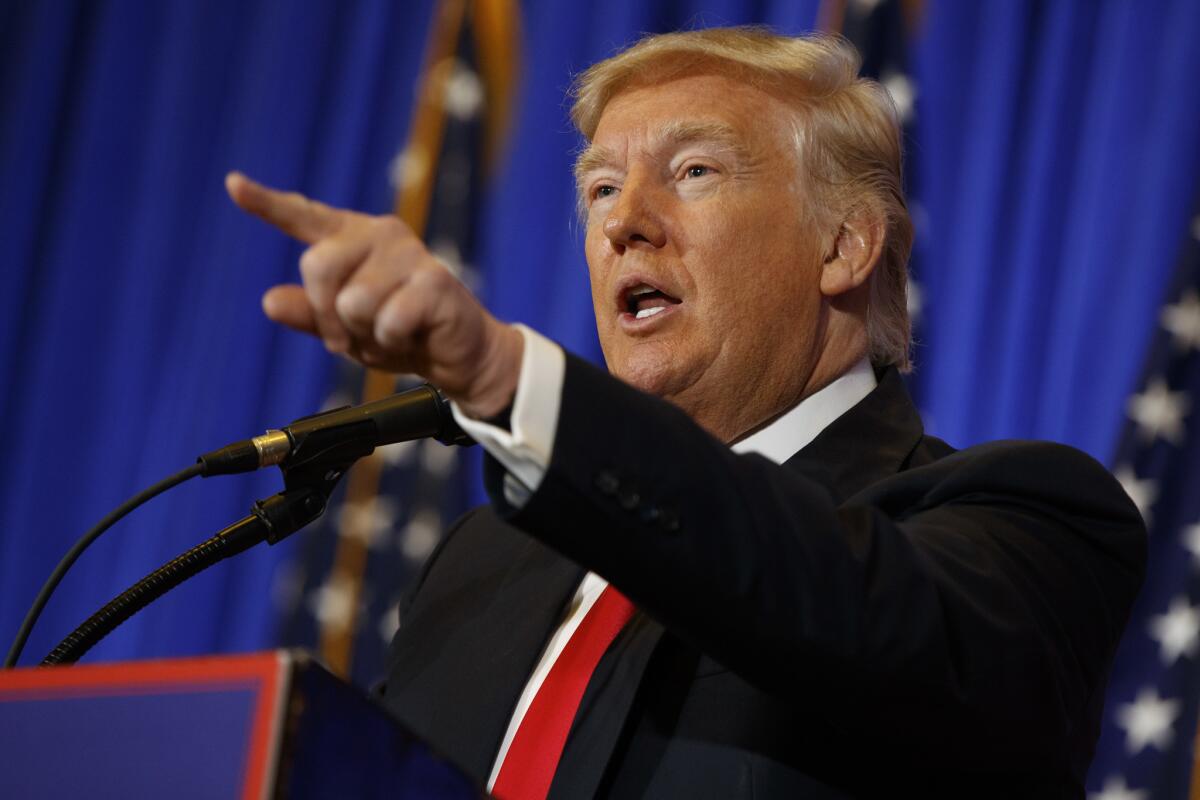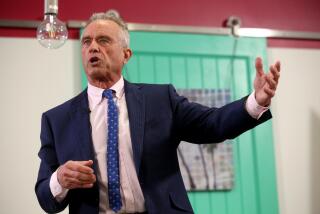Trump has vowed to slash regulations. Where he might start and the hurdles he faces

Reporting from Washington — Donald Trump’s ascendance to the White House has raised hopes among U.S. businesses for the most significant rollback of regulations since the Reagan administration.
Cutting regulations is not only a key component in Trump’s goal of doubling economic growth to 4%, but some economists regard it as potentially the most powerful agent for revving up the sluggish pace of business investment and overall productivity, the single biggest factor in improving the living standards of Americans.
“Regulatory reform, its potential, is way above either cutting taxes or stimulus spending,” said John Cochrane, senior fellow at Stanford’s Hoover Institution, who blames misguided rules for countless businesses that never got started, products that never got launched and people who never got jobs.
Consumer and public-interest groups are worried Americans may lose or see a defanging of key regulations protecting people against abusive employers, predatory lending, unsafe food and drugs and environmental pollution.
Will the Fed’s Janet Yellen ‘take away the punch bowl’ after Trump takes office? »
In a white paper issued before the election, UC Irvine economist Peter Navarro and financier Wilbur Ross, who have since been named to serve in Trump’s Cabinet, wrote that Trump would seek to reduce the regulatory cost to businesses by at least 10%, or about $200 billion annually. The paper singled out easing restrictions on the coal industry, but during the course of the campaign, Trump bashed a wide range of federal regulations, including those involving food safety, healthcare, banking and foreign-worker visas.
Undoing or revising regulations won’t be easy, however. Some, like Obamacare, will require congressional action. Many others will likely find resistance from the very agencies that wrote the rules.
What’s more, unwinding federal regulations has to go through the same lengthy process of internal analysis, budget review, inter-agency impact study and public comment period that it took to get them on the books, said Susan Dudley, who headed the regulatory review process for President George W. Bush.
“In some ways, getting rid of them is harder,” she said.
Here are three major areas that are likely to be at the top of Trump’s anti-regulation agenda:
Dodd-Frank
Passed with almost no Republican support after the 2008 financial crisis, the Dodd-Frank Wall Street Reform and Consumer Protection Act was the biggest overhaul of financial regulations since the Great Depression.
The 2,300-page legislation toughened capital requirements for banks and other financial firms, set up a powerful panel of regulators to watch for signs of instability and created the Consumer Financial Protection Bureau to oversee credit cards, mortgages, payday loans and other financial products.
Trump has called Dodd-Frank “a very negative force” in the economy. And his Treasury secretary designee, Steven Mnuchin, believes that Dodd-Frank is too complicated and an obstacle to lending, and has pledged to strip back parts of the law and make that priority No. 1 on regulatory reform.
One target will be the Volcker Rule, legislation drawn from five agencies that prohibits banks from trading for their own profit and limits their ownership of risky investments. Big banks would like to see the law weakened or killed, but that would require legislation.
Trump names UC Irvine professor and fierce China critic to new White House Trade Council »
Rep. Jeb Hensarling (R-Texas), chairman of the House Financial Services Committee, may help. He has been an outspoken critic of Dodd-Frank and last year proposed a bill that would repeal the Volcker Rule, reduce the power of the consumer bureau and allow banks to avoid stricter oversight if they opt to increase the amount of capital they hold.
Ed Mierzwinski, consumer program director for the U.S. Public Interest Research Group, is trying to rally opposition.
“We’ve gone to DEFCON-1,” he said, using the acronym for the highest alert level for the armed forces.
“We have always been very concerned about threats to these agencies, but we’re going to try to spread the message that just eight years ago our economy collapsed because of a failure of regulation. Millions of consumers lost homes, lost jobs, lost retirement savings.”
Frank Sorrentino III, chairman of ConnectOne Bank, a community lender in Englewood, N.J., doesn’t want to see Dodd-Frank thrown out. He believes rules are needed to test and provide for an orderly winding down of troubled banks whose collapse could endanger the broader financial system and economy.
Yet Sorrentino thinks the regulatory pendulum has swung too far in the other direction after being too lax, with bank examiners sometimes acting more like prosecutors than regulators. Some of the most stringent Dodd-Frank provisions don’t apply to Sorrentino because his bank hasn’t reached $10 billion in assets, a threshold that he considers arbitrary. It’s enough, he said, that compliance risks have kept him from expanding into areas like auto loans and residential mortgages.
“Anything to do with the consumer is very, very difficult to do today,” he said.
Overtime pay
Unable to push a higher federal minimum wage through Congress, President Obama has sought where he could to lift workers’ pay, which has languished, particularly for those at the bottom. One of his signature presidential actions on labor was to sharply increase the salary threshold for overtime so that more workers would qualify for time-and-a-half pay.
The move would have extended overtime pay to more than 4 million workers, according to Labor Department estimates, but a federal judge in Texas blocked the change days before it was to take effect Dec. 1. The Obama administration has appealed the judge’s decision, but even if the challenge is successful, experts don’t see the new rule surviving under Trump.
Not that it already hasn’t already prodded some employers to take action.. After Obama’s new overtime rule was issued in May, the Los Angeles advertising firm Sensis bumped up the pay of a handful of its workers above the revised salary threshold of $47,476 so that the company could maintain greater flexibility with their work hours. The previous threshold was $23,600, which meant that anybody making more than that wouldn’t necessarily have to be paid overtime rates for putting in more than eight hours a day or 40 hours a week.
But while some workers who earned salaries close to the new threshold got raises, Jose Villa, president of Sensis, said he had to convert other salaried workers, about 10% of his total staff of 80, to an hourly work schedule.
“They did not take it well,” said Villa, who has offices also in Atlanta, Austin and Washington, D.C. “For some, it was sort of viewed as almost a demotion. … Now you had to clock in and clock out. It took away a lot of autonomy from a young professional staff.”
Villa doesn’t expect the new overtime rule to last, but he has held off reverting those workers back to salary, uncertain how things will conclude. Proponents for raising overtime pay are talking about taking the fight to individual states, just as many groups have in securing higher minimum wages at the state or local level.
In the past few years, Villa said his costs for keeping up and complying with new regulations have had a snowballing effect on his bottom line. He estimates that HR and other regulatory costs now amount to as much as 4% of his overall revenue. And he says he needs 1 1/2 to two full-time employees today to handle compliance matters. Five years ago, he says, one half-time worker was enough.
Environment
For all of his campaign rhetoric, Trump isn’t expected to abolish the Environmental Protection Agency or fold it into the Energy Department, as some have suggested. Nor can Trump unilaterally cancel or renegotiate the Paris Agreement, the international pact to reduce greenhouse gases in which the U.S. promised to cut emissions up to 28% by 2025.
Trump could pull the U.S. out, but that won’t come without political costs and would nonetheless take years to withdraw under the agreement. And it isn’t clear that Trump is dead set against it.
On key issues such as global warming, Trump has waffled, first claiming that it was a Chinese hoax and only later acknowledging there seems to be some validity to it. But Trump’s pick for the EPA, Oklahoma Atty. Gen. Scott Pruitt, is an ardent critic of climate change with a history of battling environmental rules.
First off, the Trump administration will likely ease rules and standards to enhance coal-powered energy and help coal-mining workers who rallied behind him during the campaign. A prime target is the EPA’s Clean Power Plan, which Trump officials have argued forces increased investments for renewable energy at the expense of coal and natural gas and thus resulting in higher electricity rates, a statement that environmental protection groups dispute.
Trump could move to repeal Clean Power, but that would require the same extended process of promulgating a regulation to begin with, said David Goldston, director of government affairs for the Natural Resources Defense Council. Trump could change sides in court battles and stop defending the rules, but, Goldston noted, “that won’t make the litigation go away.”
What Trump could do more quickly is undo Obama’s order halting coal-mining permits and leasing rights on federal land.
The National Federation of Independent Business, a small-business lobbying group, is also betting that the Trump White House will seek to repeal the so-called Waters of the U.S. rule, which is intended to make clear which waterways would be covered by the EPA and the U.S. Army Corps of Engineers under the Clean Water Act.
Farmers, homeowners and oil companies have lined up to challenge the rule, arguing it amounts to a bureaucratic overreach that will force them to obtain more permits and hurt their ability to do business. Obama officials, environmental groups and supporters say the rule would help protect wetlands and streams, prevent flooding and ensure the safety of drinking water.
Past efforts by the Republican-controlled Congress in the 1990s and later in the George W. Bush administration suggest that attempts to weaken environmental rules like water safety may not go very far once they are in the public limelight.
“There’s a long history of going after water protections and finding that’s not the way to get off on the best foot,” Goldston said. “I think it’s because it’s not hard to grasp fundamentals why clean water is important, why you want to protect drinking water sources. Obviously this rule has been controversial,” he added of the Waters of the U.S., “but I do think that once the specific regulations are under attack in a high-profile way, especially when it’s part of a larger effort to weaken public protections, the public is not supportive and is at times even enraged.”
Follow me at @dleelatimes
ALSO:
Reality check: Manufacturers returning to U.S. may mean jobs for robots, not people
Why this is the perfect time to invest in infrastructure, and why it probably won’t happen
Millennials aren’t big spenders or risk-takers, and that’s going to reshape the economy
More to Read
Get the L.A. Times Politics newsletter
Deeply reported insights into legislation, politics and policy from Sacramento, Washington and beyond. In your inbox three times per week.
You may occasionally receive promotional content from the Los Angeles Times.












